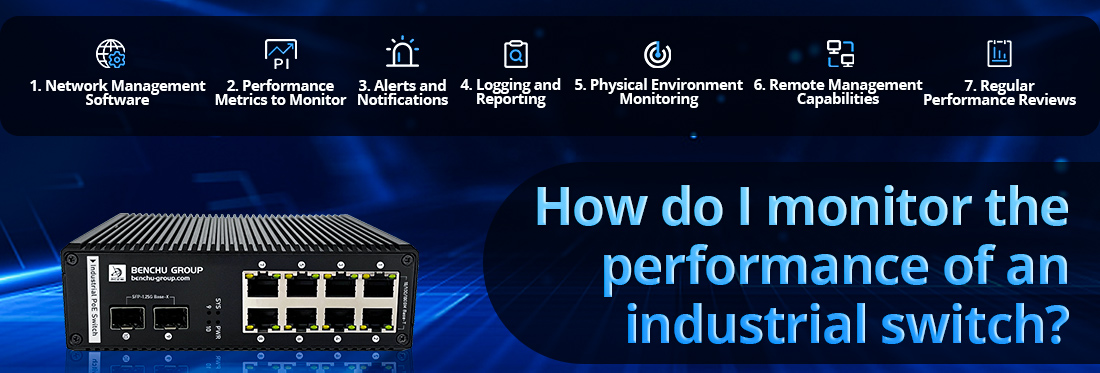
Monitoring the performance of an industrial switch is crucial for ensuring network reliability, optimizing performance, and proactively addressing potential issues. Here’s a detailed description of effective strategies and tools for monitoring industrial switch performance:
1. Network Management Software
a. Use of SNMP
--- Simple Network Management Protocol (SNMP): Most industrial switches support SNMP, which allows you to collect and manage data regarding switch performance and status.
--- Configuration: Set up SNMP agents on the switches and use a network management system (NMS) to monitor metrics such as port status, traffic levels, and error rates.
b. Comprehensive Management Tools
--- Network Management Platforms: Utilize specialized software (e.g., Cisco DNA Center, SolarWinds, PRTG) that provides an interface for monitoring switch performance, traffic patterns, and health status.
--- Dashboard Features: Look for tools that offer customizable dashboards, allowing for real-time visibility of key performance indicators (KPIs).
2. Performance Metrics to Monitor
a. Traffic Statistics
--- Bandwidth Usage: Monitor the amount of data being transmitted and received on each port to identify congestion or overutilization.
--- Traffic Types: Analyze traffic types to understand the proportion of unicast, multicast, and broadcast traffic.
b. Error Rates
--- Packet Errors: Keep track of error rates, including discarded packets, CRC errors, and collisions, which can indicate issues with cables or network configuration.
--- Port Status: Monitor the status of each port to ensure they are operational and that there are no faults.
c. Latency and Throughput
--- Latency Measurements: Measure the time it takes for packets to travel through the switch, helping identify bottlenecks in the network.
--- Throughput Rates: Assess the data transfer rates to ensure they meet operational requirements.
3. Alerts and Notifications
a. Configure Alerts
--- Thresholds: Set thresholds for critical metrics (e.g., bandwidth utilization, error rates) that trigger alerts when exceeded.
--- Notification Systems: Implement notification systems (email, SMS, or integrations with ITSM tools) to alert network administrators to potential issues in real-time.
b. Automated Responses
--- Scripts and Automation: Consider automation scripts to respond to specific alerts, such as restarting a port or redirecting traffic when certain conditions are met.
4. Logging and Reporting
a. Log Monitoring
--- Syslog Configuration: Enable syslog on switches to collect logs about events, errors, and performance metrics, which can be centralized for analysis.
--- Log Review: Regularly review logs for unusual activity, errors, or patterns that may indicate performance degradation.
b. Reporting Tools
--- Periodic Reports: Generate and review performance reports (daily, weekly, or monthly) to analyze trends over time and identify recurring issues.
--- Visualization: Use reporting tools that provide graphical representations of performance data for easier interpretation.
5. Physical Environment Monitoring
a. Temperature and Humidity Sensors
--- Environmental Monitoring: Integrate temperature and humidity sensors to monitor the physical environment where switches are located, ensuring they operate within specified limits.
--- Alerts for Environmental Conditions: Set up alerts for abnormal temperature or humidity levels that could affect switch performance and longevity.
6. Remote Management Capabilities
a. Web Interface and CLI Access
--- Management Interfaces: Use the web interface or command-line interface (CLI) for real-time monitoring and configuration changes.
--- Remote Access: Ensure secure remote access to manage switches from various locations, facilitating quick response to issues.
b. Cloud-Based Monitoring
--- Cloud Solutions: Consider cloud-based management solutions that allow for centralized monitoring and management of multiple switches across different locations.
7. Regular Performance Reviews
a. Scheduled Assessments
--- Periodic Performance Reviews: Conduct regular assessments of switch performance to evaluate network health and identify areas for improvement.
--- Capacity Planning: Use performance data to inform capacity planning and future network upgrades.
b. Collaboration with IT Teams
--- Cross-Functional Collaboration: Work with IT and OT teams to share performance insights, align network changes with operational goals, and address any issues collaboratively.
Conclusion
Monitoring the performance of an industrial switch involves a combination of utilizing network management software, tracking key performance metrics, configuring alerts, managing logs, monitoring the physical environment, and conducting regular assessments. By implementing these practices, organizations can ensure optimal switch performance, quickly identify and address potential issues, and maintain a reliable industrial network.